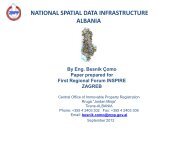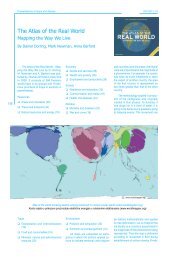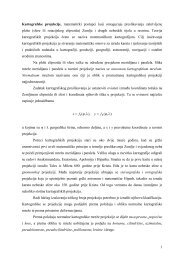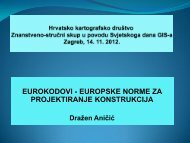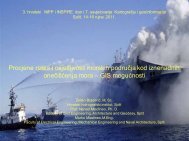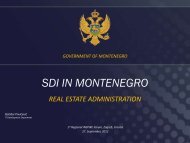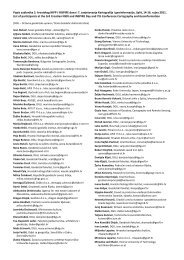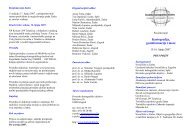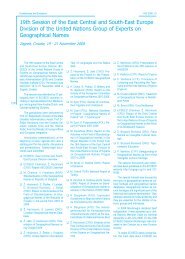pdf (471 KB)
pdf (471 KB)
pdf (471 KB)
You also want an ePaper? Increase the reach of your titles
YUMPU automatically turns print PDFs into web optimized ePapers that Google loves.
Internet KiG 2002,1Table 1. Some applications of Internet in connection with cartographyElectronic publishing:Advertising:EducationTrade:Organisation:Databases:Often raised questions:Bulletin:Connections:Software:Interactive pages:Information systems:abstracts, journals, text documents (papers, manuals), bookreviews, dictionariesservices, sources, events, software, employment, archives,address lists, conferences, seminars and exhibitions, newsmodules with instructions, textbooks, research, details aboutcourses, papers, bibliographiese.g. companies selling mapse.g. national mapping organisationstext, image, archiveproblem solutionspresenting information to wider publicRemote Sensing/GIS/Cartography/GPSdemonstration and free programs (shareware)cartography, image processinge.g. usage of various map scales as zooming interfaceswhich these data are transferred or saved.Hypermedia bases of web widen the Internetpotentials and offer to a person dealing withcomputers the possibility to provide and publishinformation, opinions, multimedia records and othermaterial to the millions of people around the world ina simple way and with small expenses.In order to understand web better, we should realizewhat hypertext and hypermedia are. Hypertextorganises information as an interwoven network ofmutually connected texts. Hypermedia is a termreferring to hypertext documents containingmultimedia objects along with the text (images,sound and video records). Through a wide range ofvarious instructions, HTML enables the usage of alltypes of media objects, which is one of morepowerful arguments proving that web is based onhypermedia (Petrić, 1995).HTML, by means of which hypertext files can bewritten, has numerous possibilities for textformatting as any other text-processing program.Apart from the text itself, the document may containimages, tables or forms enabling interactive work(Meter et al., 1995).In order to enter some file on Internet one should befamiliar with the document access manner, with thename of the computer where it can be found, thedirectory where it is saved and the file name itself.These data are contained in the URL address. URL isthe abbreviation of Uniform Resource Locator(Sušanj, Petrić 1996).Cartography and InternetGreen (1997) has researched Internet in short inconnection with maps and cartography. He states thatthere are many possible ways of using Internet incartography. Table 1 shows some of the ways inwhich cartographic information is already availablethrough Internet. Some are textual, and some in theform of maps.Maps are often applied as interfaces for otherinformation on web. They can be used only as avisual guidance, as a way of communicating theinformation, or as an example to various types ofavailable maps. Along with the development ofInternet technology there will be also the ways ofdelivering and using maps developed; e.g. the usageof animation and interactive switching on and off themap layers offer more dynamic possibilities forpresenting maps in raster and vector form, and theinteractions of users (see also Tunjić 1998).Web maps can be static and dynamic. Both groupsinclude the maps that can be viewed only andinteractive maps. The most maps on web today arestill static and not interactive. These are e.g. scannedmaps installed on web. Some very old maps difficultto be reached become available to many users in thisway (Fig. 3). Static maps can also be interactive.«Clicking» certain places we provoke someoperations, e.g. associating additional information,zooming and similar.Web has got a few possibilities for the presentationof dynamic processes by means of animation. A172
Internet KiG 2002,1Tablica 1. Neke upotrebe interneta u vezi s kartografijomElektronièko objavljivanje:saeci, èasopisi, tekstualni dokumenti (èlanci, priruènici), recenzijeknjiga, rjeèniciReklamiranje:slube, izvori, dogaðaji, softver, zapošljavanje, arhive, popisi adresa,konferencije, seminari i izlobe, vijestiObrazovanje:moduli s uputama, udbenici, istraivanja, pojedinosti o teèajevima,èlanci, bibliografijeTrgovinanpr. tvrtke koje prodaju karteOrganizacije:npr. nacionalne kartografske organizacijeBaze podataka: tekst, slika, arhivÈesto postavljana pitanja:rješenja problemaBilten:izlaganje informacija za široku publikuVeze:Daljinska istraivanja/GIS/Kartografija/GPSSoftver:demonstracijski i besplatni programi (shareware)Interaktivne stranice: kartografija, obrada slikaInformacijski sustavi: npr. upotreba razlièitih mjerila karte kao suèelja za zumiranjepodatku spremljenom na mreži bez poznavanjanačina na koji se ti podaci prenose i spremaju.Hipermedijalni temelji weba proširuju potencijaleinterneta, te čovjeku koji se ne bavi računalimapružaju mogućnost da na jednostavan način uz vrlomale troškove pribavlja i objavljuje informacije,mišljenja, multimedijalne zapise i druge materijalepred milijunskom publikom diljem svijeta.Da bi se web bolje razumio, potrebno je što boljeshvatiti što je to hipertekst, odnosno hipermedija.Hipertekst organizira informacije kao isprepletenumrežu međusobno povezanih tekstova. Hipermedijaje pojam koji se odnosi na hipertekstualne dokumentekoji pored teksta sadrže i multimedijalne objekte(slike, zvučni i videozapisi). HTML kroz širokupaletu raznih naredbi omogućava da se u webstranicamaupotrijebe svi tipovi medijalnih objekata,pa je to i jedan od jačih argumenata zbog kojih sekaže da web počiva na hipermedijalnim temeljima(Petrić, 1995).HTML pomoću kojega se mogu pisatihipertekstualne datoteke ima brojne mogućnosti zaformatiranje teksta, kao bilo koji program za obraduteksta. Osim samog teksta, unutar dokumenta mogubiti uključene i slike, tablice ili pak obrascizahvaljujući kojima je moguć interaktivni rad (Meteri dr., 1995).Da bi se pristupilo nekom dokumentu na internetu,potrebno je znati način pristupa do dokumenta, imeračunala na kojem se nalazi, direktorij u kojem jepohranjen i samo ime dokumenta. Te podatke sadržiURL-adresa. URL je skraćenica od UniformResource Locator (Sušanj, Petric 1996).Kartografija i internetGreen (1997) ukratko istražuje internet u vezi skartama i kartografijom. Prema njemu postoji mnogomogućih načina upotrebe interneta u kartografiji.Tablica 1. prikazuje neke od načina u kojima sukartografske informacije već dostupne prekointerneta. Neke su tekstualne, a druge u oblikukarata.Karte se često primjenjuju kao sučelja za drugeinformacije na webu. Mogu biti upotrijebljene samokao vizualni putokaz, kao način priopćavanjainformacija ili kao primjer mnogim različitimvrstama dostupnih karata. Kako se razvija internetskatehnologija, tako će se razvijati i načini na koje sekarte mogu isporučiti i upotrijebiti; npr. upotrebaanimacije i interaktivno uključivanje i isključivanjeslojeva karte pružaju dinamičnije mogućnosti zaprikazivanje karata u rasterskom i vektorskom oblikute interakcije korisnika (vidi također Tunjić 1998).Web-karte mogu biti statičke i dinamičke. Objeskupine uključuju karte koje se mogu samopregledavati (view only) i interaktivne karte. Većinakarata na webu danas su još uvijek statičke i nisuinteraktivne. To su npr. skanirane karte postavljenena web. Neke vrlo stare i teško dostupne kartepostaju na taj način dostupne mnogima (slika 3).Statičke karte mogu biti i interaktivne. “Klikom” napojedino mjesto izazivaju se određene operacije, npr.pridruživanje dodatnih informacija, zumiranje i sl.173
Internet KiG 2002,1Slika 3. Jedna od mnogih zbirki starih karata na internetu (URL 3)Fig. 3. One of many collections of old maps on Internet (URL 3)typical example is a globe turning around or themovement of clouds on meteorological maps.The greatest advantage of web maps from the user’spoint of view is their availability and up-to-dateness.They are available for 24 hours a day with nolimitations. The usage of CD-ROM has not solvedthe problem of up-to-dateness of maps. Only webmakes an essential progress possible. The examplesare meteorological maps, also road maps, i.e. thesituation regarding the roads being in the process ofbuilding.The availability and up-to-dateness, the two majoradvantages of web maps, are still not completelyreached. Some web maps are not regularly updated,and thus users lose confidence in these sites. It ismuch more important that there are some limitationsin availability from the practical point of view:finding web maps, language, availability toeverybody, charged web map and geodata, access toInternet, speed of data transfer. Regarding thelanguage, it must be pointed out that English isdominant. But only 10% of world population use thislanguage, and 22% is illiterate. Furthermore, if wewrite some geographic name incorrectly, we will notbe able to find the requested map or geodata.Economical factors are the main reasons forlimitations in having access to web. The dataavailable without charge are not always of thehighest quality. The limiting factors are also theInternet access costs. The requirements in thisrespect include powerful computer, modem,software, telephone costs. The greatest problem for auser is the speed of data transfer.Internet is becoming more and more important in theworld economy. It is estimated that more than 50% ofgross national product increase in the United Statesin 1999 was realised due to Internet. There are nosuch precise data for web-mapping. It is sure,however, that this part of Internet economy will bereflected in cartography as well. Web is not only thetool for advertising traditional cartographic products,e.g. maps on paper and CD-ROM, and of mappingsoftware. Creation of maps on web maps is becominga new specialisation of cartographers andcartographic firms whose products and services mustbecome available through web, too. In order tosurvive, the cartographic firms and organisations willhave to be adjusted to the rules of Internet economy,and it will not always be easy.The map contents depends to a large extent on scale.Principally, the maps on the monitor, and thus webmaps as well, have changeable scale, because theycan be enlarged and reduced (zooming). Thecartographers can apply three types of zooming increating a map.In static linear zooming the image is enlargedlinearly, but the contents remain the same. The mapis saved as an image. If it has got vector graphics, theimage is equally sharp, but if its raster graphics, thepixels become visible.174
Internet KiG 2002,1Web ima nekoliko mogućnosti za prikaz dinamičkihprocesa putem animacije. Tipičan je primjer globuskoji se okreće ili kretanje oblaka na meteorološkimkartama.Najveća prednost web-karata iz perspektive korisnikaje njihova dostupnost i aktualnost. Dostupnost je 24sata na dan bez ikakvih ograničenja. Upotreba CD-ROM-a nije riješila problem aktualnosti karata. Tekweb omogućuje bitan napredak. Primjer sumeteorološke karte, također i autokarte, tj. stanjecesta u izgradnji.Dostupnost i aktualnost, dvije glavne prednosti webkarata,nisu uvijek potpuno ispunjene. Neke webstranicenisu redovito održavane pa korisnici gubepovjerenje u te stranice. Mnogo je važnije da u praksipostoje i ograničenja u dostupnosti: pronalaženjeweb-karata, jezik, dostupnost svima, web-karte igeopodaci uz naplatu, dostupnost interneta, brzinaprijenosa podataka. Što se tiče jezika treba reći da jeengleski dominantan. Ali tek 10% svjetskogstanovništva služi se tim jezikom, a 22% jenepismeno. Nadalje, napišemo li neko geografskoime pogrešno nećemo pronaći traženu kartu iligeopodatke. Ekonomski činitelji glavni su razloziograničenja u pristupu na web. Podaci dostupni beznaplate nisu uvijek najkvalitetniji. Ograničavajućifaktor su i troškovi pristupa internetu. Uvjeti susnažno računalo, modem, softver, telefonski troškovi.Najveći problem za korisnika je brzina prijenosapodataka.Internet dobiva sve veću važnost u svjetskojekonomiji. Procjenjuje se da je više od 50%povećanja bruto domaćeg proizvoda (GDP)Sjedinjenih Američkih Država u 1999. postignutozahvaljujući internetu. Za web-kartografiju nepostoje tako precizni podaci. Sigurno je, međutim, daće taj dio internetske ekonomije naći odraza i ukartografiji. Web nije samo sredstvo za oglašavanjetradicionalnih kartografskih proizvoda, npr. karata napapiru i CD-ROM-u te kartografskog softvera.Kreiranje karata na web-stranicama postaje novaspecijalizacija kartografa ikartografskih tvrtki, čiji proizvodi iusluge moraju postati dostupni i prekoweba. Da bi preživjele, kartografsketvrtke i organizacije morat će seprilagođivati pravilima internetskeekonomije, a to neće uvijek biti lako.Sadržaj karte ovisi u velikoj mjeri omjerilu. U načelu karte na zaslonu(ekranu) monitora, pa prema tome iweb-karte imaju promjenljivo mjerilo,jer se mogu povećavati i smanjivati (zumiranje).Kartografi mogu u kreiranju karata primijeniti trivrste zumiranja.Pri statičkom linearnom zumiranju slika se linearnopovećava, ali sadržaj ostaje isti. Karta je spremljenakao slika. Ako je grafika vektorska, slika je jednakooštra, a ako je rasterska postaju vidljivi pikseli.U statičkom stupnjevitom zumiranju dostupna jeserija karata istog područja, svaka oblikovana zadrugo mjerilo. Pri zumiranju softver automatski biranajprikladniju kartu za traženo mjerilo.U dinamičkom zumiranju postoji izravna vezaizmeđu mjerila i sadržaja karte. Što je mjerilokrupnije, prikazuje se više detalja na karti. Potrebnaje izravna veza slike i baze podataka. Kartografskageneralizacija i simbolizacija najčešće se mijenja smjerilom. Naselje u sitnome mjerilu prikazuje sekružićem, a u krupnijem konturom naselja (Kraak,Brown 2001).Kad se govori o kartografiji i internetu trebaspomenuti i pristup internetu preko mobitela.Upotreba interneta preko mobitela sigurno će bitiusmjerena na najnovije vijesti, vrijeme i sport (slika4). Najvjerojatnije će se i karte prikazivati na malimekranima mobitela. Pritom će glavni izazov bitiuspostava WAP specifičnog kartografskogposlužitelja, koji će nuditi karte u formatuprikladnom za male ekrane mobitela (Peterson 2000).Multimedijska kartografijaMultimedija je interakcija više oblika medijapodržana računalom. Računalo je alat multimedije alii nezin medij. Web je dramatično povećao brojkorisnika i upotrebu produkata interaktivnemultimedije.Do približno sredine 1980-ih računala su seupotrebljavala kao pomoć u izradi karata na papiru.Napredak u pohrani podataka (CD-ROM, DVD) iinternet (web) omogućili su pod kraj 1980-ih i tokom1990-ih ulazak kartografije u eru multimedije.Multimedijska kartografija zasniva sena pet načela (Peterson 1999). Prvood tih načela govori da se karte napapiru ne mogu takmičiti sinteraktivnim medijima u bitnomsvojstvu kartografije – prikazu ikomunikaciji prostornog i dinamičkogsvijeta.Drugo načelo vezano je uzdistribuciju karata. Izum tiskarstvaSlika 4. Pregledavanje podataka s interneta na zaslonu mobilnog telefona (URL 4)Fig. 4. Data browsing from Internet on mobile phone screen (URL 4)175
Internet KiG 2002,1Slika 5. Eksperimentalna interaktivna karta cesta susjedne nam Madžarske. Sadržaj statusne trake ispisujekoordinate i podatke o naselju iznad koje je pokazivač miša (URL 5)Fig. 5. Experimental interactive road map of the neighbouring country Hungary. The content of thestatus tape writes the coordinates and data about the settlement with mouse indicator above it (URL 5)In static graduated zooming, a series of maps of thesame area is available, every one of them beingformed for another scale. In the process of zooming,the software automatically selects the most adequatemap for the requested scale.In dynamic zooming there is a direct connectionbetween the scale and the contents of a map. Thelarger the scale, the more details are presented on amap. A direct connection between the image anddatabase is needed. Map generalisation andsymbolization are most often changed with the scale.A settlement in small scale is presented with a cross,and in larger scale with the contour of the settlement(Kraak, Brown 2001).When speaking about cartography and Internet oneshould mention the access to Internet through mobilephone as well. The usage of Internet through mobilephone will surely be directed towards the most recentnews, weather and sport (Fig. 4). Most probably themaps will also be presented on small mobile phonescreens. The major challenge in this respect will bethe establishment of WAP specific cartographicserver that will offer maps in a format suitable forsmall mobile phone screens (Peterson 2000).Multimedia cartographyThe multimedia is an interaction of several forms ofcomputer-aided media. Computer is a multimediatool, but also its medium. Web has dramaticallyincreased the number of users and the usage ofproducts of interactive multimedia.Until approximately mid-1980-ties, the computerswere used as help in producing maps on paper. Theadvance in saving data (CD-ROM, DVD) andInternet (web) enabled at the end of 1980-ties andduring 1990-ties the entrance of cartography into themultimedia age.Multimedia cartography is based on five principles(Peterson 1999). The first of these principles saysthat the maps on paper cannot compete withinteractive media in the essential property ofcartography – presentation and communication ofspatial and dynamic world.The second principle is connected with thedistribution of maps. The invention of printing hasmade it possible for maps to reach much greaternumber of people than ever before. Analogously, thecomputer networks have today even more speeded upthe distribution of maps. The tendency goes towardsinteractive maps that make it possible for users tochange the perspective, projection and detail degree.Also, the maps are more current. E.g. themeteorological maps change every few hours.The third principle is based on problems connectedwith the usage of maps. Many people havedifficulties in using maps and have therefore verybad notion of the landscape surrounding them. Thesolutions could be offered by the interactivemultimedia. A map user is not limited any more toonly one view offered by the classical map but can176
Internet KiG 2002,1omogućio je da karte dopru do mnogo većeg brojaljudi nego prije toga. Analogno tome danas suračunalne mreže ubrzale distribuciju karata jošznatno više. Internet, a posebno web redefinirao jenačin izrade i upotrebe karata. Tendencija je premainteraktivnim kartama koje omogućuju korisnikumijenjanje perspektive, projekcije i stupnjadetaljnosti. Karte su osim toga suvremenije. Npr.meteorološke karte mijenjaju se svakih nekoliko sati.Treće načelo zasniva se na problemima vezanim uzupotrebu karata. Mnogo ljudi ima teškoća u upotrebikarata i stoga imaju vrlo lošu predodžbu krajolikakoji ih okružuje. Rješenje bi mogla pružitiinteraktivna multimedija. Korisnik karte nije višeograničen na samo jedan pogled koji nudi klasičnakarta već može isprobati razne alternativne prikazekoji će mu pomoći da stvori bolju sliku krajolika.Četvrto načelo vezano je uz suštinsku vrijednostmultimedije i uvjerenje da multimedija vodi dopoboljšanog prijenosa informacija i znanja. Postojeistraživanja koja potvrđuju ali i osporavaju tetvrdnje.Peto načelo govori o općoj moralnoj obavezikartografa da prostorne informacije na efektivannačin prosljeđuje do što većeg broja korisnika.Kartografija je u procesu promjene. Nužno jepromijeniti i neke ustaljene definicije. Npr. trebalo biredefinirati i pojam karte tako da se odnosi nainteraktivni kartografski prikaz. Ako korisnik nemože kontrolirati proces izrade karte, onda to nijekarta. Ako nema mogućnosti interakcije, to takođernije karta. Karta nije ni prikaz, koji ne omogućujeanimaciju. Ono što mi danas nazivamo kartom to susamo statički elementi karte.Dinamičke karte, čiji se sadržaj mijenja nakorisnikov zahtjev, općenito su dostupne na webu(slika 5). Uskoro će ta dinamičnost imati mnogo većemogućnosti:• dinamički smještaj imena objekata na optimalnamjesta• generiranje pravokutne mreže ili mreže meridijana iparalela na karti koju stvaramo• umetanje detaljne karte u kartu sitnijeg mjerila• stvaranje datoteke za kvalitetan tisak, na osnovidinamički kreirane karte, direktno iz webpreglednika.Kakva je u svemu tome uloga kartografa? Kartografimoraju, naravno, identificirati najprikladnijetehnologije za pripremu i distribuciju kvalitetnihkarata na webu i investirati u njih. Oblikovanjekarata za web je proširenje djelatnosti kartografa,koje zahtijeva nove načine oblikovanja. Kartografi semoraju intenzivno posvetiti tome novom poslu akone žele taj važan dio tržišta prepustiti stručnjacimadrugih struka. Kroz izradu digitalnih karatakartografi su već stekli većinu potrebnih znanja.Dodatno su im još potrebna znanja (Wilfert 1998):• u oblikovanju dokumenata s HTML-om• u izradi digitalnih dokumenata prilagođenih prikazuna zaslonu monitoraSlika 6. Web stranice Geodetskog fakulteta u Zagrebu (URL 7)Fig. 6. Web pages of the Faculty of Geodesy in Zagreb (URL 7)177
Internet KiG 2002,1Slika 7. Interaktivna karta Jadranskog mora (URL 10)Fig. 7 Interactive map of the Adriatic Sea (URL 10)try various alternative presentations that will helphim/her to create a better landscape image.The fourth principle is connected with the essentialvalue of multimedia and it is believed thatmultimedia is leading to the improved informationand knowledge transfer. There is also researchconfirming, but also denying these statements.The fifth principle speaks about general moralobligation of cartographers to pass on spatialinformation in an effective way to the as largenumber of users as possible.Cartography is in the process of changing. It isnecessary to change some established definitions aswell. E.g. the notion of map should be redefined sothat it would refer to the interactive cartographicpresentation. If a user cannot control the process ofmap production, than it is not a map. If there is nopossibility for an interaction, this is also not a map.The map is not the presentation without enablinganimation. What we call map today are the only thestatic map elements.Dynamic maps the contents of which are changed asrequested by users are generally available on web(Fig. 5). Very soon, this dynamic feature will havemuch larger possibilities:• dynamic placement of object names at optimal places• generating a grid or a graticule on the map we create• inserting a detailed map into the small scale map• creating files for high quality printing on the basis ofdynamically created map, directly from web-browser.Fig. 5. Experimental interactive road map of theneighbouring country Hungary. The content of thestatus tape writes the coordinates and data about thesettlement with mouse indicator above it (URL 5)What is the role of a cartographer in all this?Cartographers must, of course, identify the mostsuitable technologies for preparation and distributionof high quality maps on web and make investments.The creation of maps for web widens the activity of acartographer requesting new ways of creating.Cartographers must be intensively dedicated to theirnew job if they do not want to leave this veryimportant part of the market to the other professions.Producing digital maps, cartographers have alreadyacquired the majority of necessary knowledge. Theyneed some additional skills (Wilfert 1998):• in creating documents with HTML• in producing digital documents adapted to thepresentation on the screen• in audio- and video technique• in programming, e.g. in Java.The evolution of payment system through Internetwill make it possible to apply maps more and more invarious areas. Some time will pass until the newmarket is settled, but its growth will be accelerated ifsupported by the structure of prices. The prices ofordered maps can be based on the map contents andits size. Web-cartography according to the orders ofusers is a great opportunity for various industrialgroups to work together very profitably (Willcox1999).178
Internet KiG 2002,1• o audio- i videotehnici• programiranju, npr. u Javi.Evolucija sustava plaćanja preko interneta omogućit će isve veću primjenu karata u raznim područjima. Dok senovo tržište ne ustali, proći će neko vrijeme, ali ćenjegov rast biti ubrzan ako ga struktura cijena budepodržavala. Cijene naručenih karata mogu se temeljitina sadržaju karte i njenoj veličini. Web-kartografijaprema narudžbama korisnika velika je prilika darazličite industrijske skupine zajednički rade vrloprofitabilno (Willcox 1999).Za izradu karata na webu postoji na tržištu veći brojsoftverskih paketa. Neki od najpoznatijih jesu (Limp1999):• ArcView IMS (ESRI Inc.)• GeoMedia Web Map (Intergraph Corp.)• MapGuide (Autodesk Inc.)• Smallworld Web (Smallworld).GIS i internetWeb-GIS je relativno novi pojam. Označavaprimjenu tehnologije interneta s njegovim normamau prijenosu i prikazu podataka u GIS-u. Korisnostodređenog GIS-projekta znatno će se povećati akošto veći broj korisnika ima jednostavan pristuppodacima GIS-a pri čemu se ti podaci mogu spajati spodacima iz drugih sustava, analizirati i prikazati. Utu svrhu ujedinile su se praktički sve tvrtke prisutnena tržištu GIS-a i osnovale OpenGIS-Consortium(OGC) (Kurzwernhart 1999).Članice OGC-a nedavno su predložile i prikazaleznačajno otvoreno sučelje koje bi moglo izazvatirevoluciju u upotrebi geoprostornih informacija nawebu (URL 6). Radi se o rezultatu projekta omogućnosti zajedničkog rada više različitih sustavaili uređaja na mreži pod nazivom Testiranjekartografije na webu (Interoperability program WebMapping Testsbed – WMT). Činjenica je da tisućeweb-stranica sadrže slikovne prikaze ili karte Zemlje,ali ne funkcioniraju zajedno. Zamislimo upotrebupreglednika za web koji ima bezgraničan pristup i skojim se može pregledavati i istraživati velik, šaroliki široko distribuiran sadržaj geoprostornih podataka.To je cilj projekta WMT OGC-a. Dugo vremenaizolirane za primjene na stolnim računalima iliuredskim poslužiteljima (serverima), geoprostornetehnologije danas se transformiraju kako bi bile štobolje prilagođene webu. Geoosposobljene (Geoenabled)web usluge uskoro će integrirati prostor ivrijeme pri odlučivanju, učenju i istraživanjima. Teće usluge davati više od samih karata, ali karte će bitivažan početak. Projekt WMT temelji se na polaznojdefiniciji karte kao filtriranog podskupageoprostornih podataka u skladu s položajem,mjerilom i namjenom, a prikazanog kartografskimznakovima. Prema Willcoxu (1999), rezultat će sepokazati fundamentalnim pri distribuciji karataizabranog i bogatog sadržaja. Prema prijedloguOGC-a, sadržaj pojedine karte može, teoretski, bitineograničen. Štoviše, podaci se mogu prikupljati izizvora različitih tehnologija i objedinjavati u istuSlika8. Web stranice Međunarodne kartografske udruge (URL 13)Fig. 8. Web pages of the International Cartographic Association (URL 13)179
Internet KiG 2002,1For the production of web maps there is a largenumber of software packages available in the market.Some of the most well known are (Limp 1999):• ArcView IMS (ESRI Inc.)• GeoMedia Web Map (Intergraph Corp.)• MapGuide (Autodesk Inc.)• Smallworld Web (Smallworld).GIS and InternetWeb-GIS is a relatively new term. It denotes theapplication of Internet technology with its standardsin the transfer and presentation of data in GIS. Theusefulness of a certain GIS project will besignificantly increased if a larger number of users hasgot a simple access to the data in GIS whereby thesedata can be connected with the data from othersystems, then analysed and presented. For thispurpose practically all firms present in the GISmarket have united and founded Open-GIS-Consortium (OGC) (Kurzwernhart 1999).The members of OGC have recently suggested andpresented a significant open interface that couldcause revolution in using geospatial information onweb (URL 6). It refers to the result of the projectabout the possibilities of mutual work to beperformed by more various systems or devices in thenetworks titled Interoperability program WebMapping Testbed – WMT. The fact is that thousandsof web maps contain images or maps of the Earth,but they do not operate together. Let us imagine theusage of a web browser having limitless access andthe one that we can browse and research a great, richand widely distributed content of geospatial datawith. This is the goal of the project WMT in OGC. Along time isolated for application of desktopcomputers or office servers, geospatial technologiesare transformed today in order to be adjusted to webas well as possible. Geo-enabled web services willsoon integrated space and time in the process ofdeciding, learning and researching. These serviceswill give more than the maps themselves, but themaps will be an important beginning. The projectWMT is based on the initial definition of a map as afiltered subgroup of geospatial data in accordancewith the position, scale and purpose, and presentedby means of cartographic signs. According toWillcox (1999), the results will prove itself asfundamental in the distribution of maps havingselected and rich contents. According to the proposalof OGC, the contents of individual map can betheoretically limitless. Moreover, the data can begathered from the sources of various technologiesand united in the same map according to the user’sneeds. Internet is a cartographic database. This is acrucial assumption because it makes it possible forusers to find and combine various map layers of oneand the same geographic area without specialsoftware, regardless of the differences the ownersmay have in saving, analysing and presenting data.Web-pages with cartographic contentsThe Department for Cartography at the Faculty ofGeodesy, University of Zagreb has got its own pageson Internet within the scope of web pages belongingto the Faculty of Geodesy (URL 7) (Fig. 6). Thepages contain the following: history, employees,teaching activity, projects, publications, hardware,software.In the communication of state geodetic andcartographic organisations (SGCO) with the users oftheir services, web has got a special role. Kraak andBrown (2001) state the contents that web pages ofSGCO should contain:• organisation information• information about analogous products: descriptiveinformation, map samples that can be downloaded,general sheets (only general or interactive),information about prices; whether direct ordering ispossible?• information about digital products: descriptiveinformation, digital map samples that can bedownloaded, information about prices; whether directordering is possible?• apart from mother tongue, some information should begiven in one of the world languages as well.From the address (URL 8) one can reach web pagesof any of 70 (June 2001) SGCO around the world.SGCO of e.g. the Netherlands, Great Britain, Canada,the USA and Australia contain all previouslymentioned data. SGCO of the Republic of Croatia,the State Geodetic Administration, has got its webpages at the address (URL 9). The pages containamong other things the Catalogue of the State Surveyand Real Estate Cadastre Data, and the price list forthese data with the data about topographic maps inanalogous and digital form stated there as well.On the pages of the Croatian HydrographicalInstitute in Split (URL 10) there is an interactive mapof the Adriatic Sea (Fig. 7). Clicking some placesone can get a detailed map of that area enabling alsothe presentation of a map in even larger scale. Thepages also contain the Catalogue of Sea Maps andNavigation Publication.On the pages of the Section of Cartography in theCroatian Geodetic Society (URL 11) there are the180
Internet KiG 2002,1kartu prema korisnikovim potrebama. Internet jekartografska baza podataka. To je presudnapretpostavka jer omogućuje korisnicima da bezspecijalnog softvera lako nađu i kombinirajurazličite slojeve karte jednog te istog geografskogpodručja, bez obzira na vlasničke razlike uspremljenim podacima, analizama i prikazima.Web-stranice s kartografskimsadržajimaZavod za kartografiju Geodetskog fakultetaSveučilišta u Zagrebu ima svoje stranice na internetuu sklopu web-stranica Geodetskog fakulteta (URL 7)(slika 6). Stranice sadrže sljedeće odjeljke: povijest,djelatnici, nastava, projekti, publikacije, hardver,softver.U komunikaciji državnih geodetsko-kartografskihorganizacija (DGKO) s korisnicima njihovih uslugaweb ima posebno važnu ulogu. Kraak i Brown (2001)navode sadržaje koje bi web-stranice DGKO trebalesadržavati:• organizacijske informacije• informacije o analognim proizvodima: opisneinformacije, uzorci karata koji se mogu učitati(download), pregledni listovi (samo pregledni iliinteraktivni), informacije o cijenama; je li mogućedirektno naručivanje?• informacije o digitalnim proizvodima: opisneinformacije, uzorci digitalnih karata koji se moguučitati, informacije o cijenama; je li moguće direktnonaručivanje?• osim na vlastitom jeziku neke informacije morale bibiti i na jednom od svjetskih jezika.S adrese (URL 8) može se doći na web-stranice bilokoje od 70 (lipanj 2001.) DGKO sa svih kontinenata.DGKO npr. Nizozemske, Velike Britanije, Kanade,SAD i Australije sadrže sve prethodno navedenepodatke. DGKO Republike Hrvatske, Državnageodetska uprava, ima svoje web-stranice na adresi(URL 9). Stranice sadrže pored ostalog i Katalogpodataka državne izmjere i katastra nekretnina tecjenik tih podataka u kojem se nalaze i podaci otopografskim kartama u analognom i digitalnomobliku.Na stranicama Hrvatskoga hidrografskog instituta izSplita (URL 10) nalazi se i interaktivna kartaJadranskoga mora (slika 7). Klikom na pojedinamjesta dobiva se detaljnija karta tog područja, kojaopet omogućuje dobivanje karte u još krupnijemmjerilu. Stranice sadrže i Katalog pomorskih karata inavigacijskih publikacija.Na stranicama Sekcije za kartografiju Hrvatskogageodetskog društva (URL 11) nalaze se na hrvatskomi engleskom jeziku podaci o osnovnim ciljevima izadacima Sekcije, povijesti Sekcije te njezinimaktivnostima.Osnovni podaci o zbirci zemljopisnih karata i atlasaNacionalne i sveučilišne knjižnice u Zagrebu moguse naći na adresi (URL 12) ako se izaberu Usluge ipotom Čitaonice i zbirke.Stranice Međunarodne kartografske udruge(International Cartographic Association – ICA)(URL 13) (slika 8) sadrže na engleskom ifrancuskom jeziku ove informacije: plan aktivnostiza dvije godine, novosti, natječaji, publikacije, statuti ostali dokumenti, povjerenstva, članovi, srodneudruge. ICA je uočila važnost interneta zakartografiju i osnovala povjerensto Maps andInternet. Svrha je povjerenstva proučavanje iunapređivanje upotrebe karata na internetu.Na internetu se mogu naći i udžbenici iz područjakartografije. Jedan od najnovijih je: Menno-JanKraak i Allan Brown, Web cartography –developments and prospects objavljen 2001. Webstranicetog udžbenika (URL 14) sadrže kratkesadržaje svih poglavlja. Sve slike iz knjige na tim sustranicama u boji, a kad je to bitno one su dinamičkei interaktivne da bi ilustrirale sve one mogućnosti okojima se u knjizi raspravlja. Uz svako poglavljedane su, osim popisa literature, i hiperveze (URLovi)na dokumente u kojima se nalaze dateljnijeinformacije ili ilustracije o temama koje se upojedinom poglavlju obrađuju. Svi ti URL-ovi(ukupno 344) izravno su dostupni s web-stranica teknjige.Kako na webu pronaći karte koje su nam potrebne?Pravog odgovora nema, jer ne postoje istraživanja o181
Internet KiG 2002,1data about the basic goals and tasks of the Sectiongiven in Croatian and English, about its history andactivities.The basic data about the collection of geographicmaps and atlases in the National and UniversityLibrary in Zagreb can be found at the address (URL12) after selecting Services and then Libraries andcollections.The pages of the International CartographicAssociation – ICA (URL 13) (Fig. 8) contain thefollowing information in English and French: theplan of activities for two years, news, competitions,publications, statute and other documents,commissions, members, related associations. ICA hasnoticed the importance of Internet for cartographyand has founded the commission titled Maps andInternet. The purpose of this commission is to studyand advance the map usage on Internet.On Internet one can also find textbooks from thefield of cartography. One of the latest is: Meno-JanKraak and Allan Brown, Web cartography –developments and prospects published in 2001. Webpages of this textbook (URL 14) contain abstracts ofall chapters. All pictures from the book can be foundon these pages in colour, and if it is of essentialsignificance, they are dynamic and interactive inorder to illustrate all the possibilities that arediscussed in the book. All chapter are accompaniedby references lists and hyperlinks (URL-s) todocuments where one can find more detailedinformation or illustrations of topics dealt with insingle chapters. All these URL-s (altogether 344) aredirectly accessible from web page of the book.How can we find the maps we need on web? There isno right answer to that question because there is noresearch carried out about using maps on web(Kraak, Brown 2001). One of the solutions is the useof web browsers. One can search by means of keywords, e.g. «maps» + «Croatia». A very successfulweb browser is Google (URL 15). For the users fromCroatia the interface is in Croatian. If we selectadvance searching and then with specific phrase, andthen write energy map of Croatia, we will get webpages with the requested contents. If we use keywords while searching, we will not always get a newmap as a result, but the texts about such maps. If wesearch only for maps, then much more adequatebrowsers are those based on catalogue with index.Such browser is HotBot (URL 16). In the groupReference there is a subgroup Maps. If we click onMaps, a list of new subgroups is opened with linkson web pages where these maps can be found. Onthese pages the maps are often grouped according togeographic units, e.g. states that can be selected froma corresponding menu. Similar possibilities areoffered by the search program AltaVista (URL 17)that opens the subgroup Maps in the group Tools.For the purpose of browsing the Croatian web-spacethe program CARNet (Croatian Academic andResearch Net) (URL 18) can be of very good service.If we write the key word zemljovid (map) we will getthe addresses with links to web pages containinggeographic maps as well.There are also specialised cartographic web sites onweb, e.g. MapQuest (URL 19). It is often cited thatthese are the most often visited cartographic web pagesin the world. For example in March 2000 more than 5.5million users visited these pages. However, the speedand ease of finding information on MapQuest go at theexpense of the quality of cartographic creation (Kraak,Brown 2001). Political and physical maps and statisticdata about many countries can be found on web pagesAtlapedia online (URL 20).A very good address to search for geographic maps isalso Odden’s Bookmarks (URL 21). It was created inthe Geographic Department of the University inUtrecht. It contains more than 14 000 links (August2001) to various cartographic materials. From 1996 upto now there have been more than 1.4 million visits tothese pages registered. If we type e.g. Zagreb into thefield Search, we will get among other things a new planof Zagreb in large scale divided into several sheets. Thearrows around every sheet enable quick switching overto the adjacent sheet.Web page of the geodetic firm GEO-GAUSS d.o.o.from Čakovec is the source of many cartographicinformation (URL 22). Under the tip Kartografskiservisi (Cartographic services) there are links to overfifty addresses with cartographic contents (maps, cityplans, atlases, satellite images, organisations, portalsetc.). On the pages of this firm there are also the plansof seventy-six Croatian cities (Plans of Croatian Cities),for many cities even several plans (January 2002). Thevalue of these pages has been noticed by ourinformation magazines BUG (20021) and PCChip(2001).References:BUG (2001): Novo na hrvatskom Webu (New on CroatianWeb, in Croatian), BUG 2001, 104-105, 148.Debevc, M. (1996): Škola oblikovanja WWW dokumenata(School of Creating WWW documents, in Croatian).WIN.INI, br. 3, 1-5, Zagreb.Green, D. R. (1997): Cartography and the Internet. TheCartographic Journal, 1, 23-27.Kraak, M-J., Brown, A. (Ed.) (2001): Web Cartographydevelopments and prospects. Taylor & Francis, London182
Internet KiG 2002,1upotrebi karata na webu (Kraak, Brown 2001). Jednood rješenja su programi za pretraživanje (tražilice).Traži se pomoću ključnih riječi, npr. “maps” +“Croatia”. Vrlo uspješna tražilica je Google (URL15). Za korisnike iz Hrvatske sučelje je nahrvatskom. Izabere li se napredno pretraživanje ipotom s određenom frazom te upiše npr. energy mapof croatia, dobit će se web-stranice s traženimsadržajem. Ako se u traženju služimo ključnimriječima, rezultat neće uvijek biti karta, već i tekstovio takvim kartama. Tražimo li samo karte, tada suprikladnije tražilice koje se temelje na katalogu sindeksiranim sadržajem. Takva je tražilica HotBot(URL 16). U skupini Reference postoji podskupinaMaps. Kliknemo li na Maps otvara se popis novihpodskupina s vezama na web-stranice gdje se te kartemogu naći. Na tim stranicama karte su čestogrupirane prema geografskim jedinicama, npr.državama, koje se mogu birati iz odgovarajućegizbornika. Slične mogućnosti pruža i tražilicaAltaVista (URL 17), koja u skupini Tools uključujepodskupinu Maps.više od 14 000 veza (kolovoz 2001) na različitekartografske materijale. Od 1996. do danasregistrirano je više od 1.4 milijuna posjeta timstranicama. Utipkamo li u rubriku Search npr.Zagreb, dobit ćemo međuostalim i novi plan Zagrebau krupnom mjerilu podijeljen na više listova. Streliceoko svakog lista omogućuju brzi prijelaz na susjednilist.Web-stranice geodetske tvrtke GEO-GAUSS d.o.o. izZa pretraživanje hrvatskog web-prostora dobro ćeposlužiti tražilica organizacije CARNet (Hrvatskaakademska i istraživačka mreža) (URL 18). Upišemoli ključnu riječ zemljovid, dobit ćemo adrese svezama na web-stranice koje sadrže i geografskekarte.Postoje na webu i specijalizirani kartografski čvorovi(web site), npr. MapQuest (URL 19) Često se navodida su to najposjećenije kartografske web-stranice nasvijetu. Npr. u ožujku 2000. te je stranice posjetiloviše od 5.5 milijuna korisnika. Međutim, brzina ilakoća pronalaženja informacija na MapQuestu idena štetu kvalitete kartografskog oblikovanja (Kraak,Brown 2001). Političke i fizičke karte te statističkipodaci o mnogim zemljama mogu se naći na webstranicamaAtlapedia online (URL 20).Vrlo dobra adresa za traženje geografskih karata je iOdden’s Bookmarks (URL 21). Nastala je uGeografskom odjelu Sveučilišta u Utrechtu. SadržiČakovca izvor su mnogih kartografskih informacija(URL 22). Pod natuknicom Kartografski servisinalaze se veze (linkovi) na oko pedeset adresa skartografskim sadržajima (karte, planovi gradova,atlasi, satelitski snimci, organizacije, portali i dr.).Na stranicama te tvrtke nalaze se i planovisedamdeset i šest hrvatskih gradova (Planovihrvatskih gradova), za mnoge gradove i po nekolikoplanova (siječanj 2002). Vrijednost tih stranica uočilisu i naši informatički časopisi BUG (2001) i PCChip(2001).Literatura:BUG (2001): Novo na hrvatskom Webu. BUG 2001, 104-105,148.Debevc, M. (1996): Škola oblikovanja WWW dokumenata.WIN.INI, br. 3, 1-5, Zagreb.Green, D. R. (1997): Cartography and the Internet. TheCartographic Journal, 1, 23-27.Kraak, M-J., Brown, A. (Ed.) (2001): Web Cartographydevelopments and prospects. Taylor & Francis, Londonand New York.Kurzwernhart, M. (1999): Neue GIS-Technologien – wasbringen sie in der Praxis ? VGI 1, 13-21.Limp, F. (1999): Don’t hit warp speed with the wrongequipment. GEOEurope 12, 18-22.Meter, D., Sušanj, D., Breyer, H. i Čuček, A-M. (1995):Internet@Hr - Kako na mrežu iz Hrvatske. Znak, Zagreb.PCChip (2001): Karte gradova. PCChip 2001, 76, 83.183
Internet KiG 2002,1and New York.Kurzwernhart, M. (1999): Neue GIS-Technologien – wasbringen sie in der Praxis ? VGI 1, 13-21.Limp, F. (1999): Don’t hit warp speed with the wrongequipment. GEOEurope 12, 18-22.Meter, D., Sušanj, D., Breyer, H., Čuček, A-M. (1995):Internet@Hr – Kako na mrežu iz Hrvatske (Internet@Hr –How to Reach the Net from Croatia, in Croatian). Znak,Zagreb.PCChip (2001): Karte gradova (City Maps, in Croatian),PCChip 2001, 76, 83.Peterson, M. P. (1999): Elements of multimedia cartography.In: W. Cartwright, M. P. Peterson, G. Gartner (editors),Multimedia cartography, Springer, 3-40.Peterson, M. P. (2000): Maps and the Internet. GIMInternational, 9, 12-15.Petrić, D. (1995): Naučite HTML i oblikujte sami efektneWorld Wide Web stranice (Learn HTML and CreateYourselves Striking World Wide Web Pages). Znak,Zagreb.Sušanj, D., Petrić, D. (1996): Velika knjiga o World WideWebu (A Great Book on World Wide Web). Znak, Zagreb.Tunjić, I. (1998): Kartografija na Internetu. (Cartography onInternet), Seminar Work, University of Zagreb, Faculty ofGeodesy, Zagreb.Willcox, I. (1999): High quality map delivery: The Webapplication the industry forgot. GEOEurope 12, 16-17.Wilfert, I. (1998): Internet und Kartographie. U: 40 JahreKartographieausbildung an der Technischen UniversitätDresden 1957-1997, Technische Universität Dresden,Institut für Kartographie, Dresden 51-61.URL addresses:URL 1: http://home.computer.net/~dibianco/internet.gifURL 2: http://www.iw3c2.org/Conferences/2002Honolulu/Logo.jpegURL 3: http://www.davidrumsey.comURL 4: http://www.mc-wetter.de/produkte/images/wap.gifURL 5: http://www.mc-wetter.de/produkte/images/wap.gifURL 6: Open GIS Consortium Web Mapping Testbed PublicPagehttp://www.opengis.org/wmtURL 7: University of Zagreb, Faculty of Geodesyhttp://www.geof.hrURL 8: ITC – National Mapping Agencies and the WorldWide Webhttp://www.itc.nl/~carto/research/nmoURL 9: State Geodetic Administration, Zagrebhttp://www.dgu.tel.hr/dguURL 10: Hydrographic Institute of the Republic of Croatia,Splithttp://www.dhi.tel.hrURL 11: Section for cartography, Croatian Geodetic Society,Zagrebhttp://www.geof.hr/hgd/kartoURL 12: National and University Library, Zagrebhttp://www.nsk.hrURL 13: International Cartographic Association (ICA)http://www.icaci.orgURL 14: Menno-Jan Kraak and Allan Brown, Webcartography – developments and prospectshttp://kartoweb.itc.nl/webcartography/webbookURL 15: Googlehttp://www.google.comURL 16: HotBothttp://www.hotbot.comURL 17: AltaVistahttp://www.altavista.comURL 18: CARnethttp://www.carnet.hrURL 19: MapQuesthttp://www.mapquest.comURL 20: Atlapedia onlinehttp://www.atlapedia.comURL 21: Odden’s Bookmarkshttp://oddens.geog.uu.nl/URL 22: Geodetic firm GEO-GAUSS d.o.o. from Čakovechttp:/www.geo-gauss.hrNedjeljko FrančulaDražen Tutić184
Internet KiG 2002,1Peterson, M. P. (1999): Elements of multimedia cartography.U: W. Cartwright, M. P. Peterson, G. Gartner (editors),Multimedia cartography, Springer, 3-40.Peterson, M. P. (2000): Maps and the Internet. GIMInternational, 9, 12-15.Petrić, D. (1995): Naučite HTML i oblikujte sami efektneWorld Wide Web stranice. Znak, Zagreb.Sušanj, D. i Petrić, D. (1996): Velika knjiga o World WideWebu. Znak, Zagreb.Tunjić, I. (1998): Kartografija na Internetu. Seminarski rad,Sveučilište u Zagrebu, Geodetski fakultet, Zagreb.Willcox, I. (1999): High quality map delivery: The Webapplication the industry forgot. GEOEurope 12, 16-17.Wilfert, I. (1998): Internet und Kartographie. U: 40 JahreKartographieausbuildung an der Technischen UniversitätDresden 1957-1997, Technische Universität Dresden,Institut für Kartographie, Dresden 51-61.URL adrese:URL 1: http://home.computer.net/~dibianco/internet.gifURL 2: http://www.iw3c2.org/Conferences/2002Honolulu/Logo.jpegURL 3: http://www.davidrumsey.comURL 4: http://www.mc-wetter.de/produkte/images/wap.gifURL 5: http://www.mc-wetter.de/produkte/images/wap.gifURL 6: Open GIS Consortium Web Mapping Testbed PublicPagehttp://www.opengis.org/wmtURL 7: Geodetski fakultet Sveučilišta u Zagrebu http://www.geof.hrURL 8: ITC - National Mapping Agencies and the WorldWide Web http://www.itc.nl/~carto/research/nmoURL 9: Državna geodetska uprava, Zagrebhttp://www.dgu.tel.hr/dguURL 10: Hrvatski hidrografski institut, Splithttp://www.dhi.tel.hrURL 11: Sekcija za kartografiju Hrvatskoga geodetskogdruštva, Zagrebhttp://www.geof.hr/hgd/kartoURL 12: Nacionalna i sveučilišna knjižnica, Zagrebhttp://www.nsk.hrURL 13: International Cartographic Assocciation (ICA)http://www.icaci.orgURL 14: Menno-Jan Kraak and Allan Brown, Webcartography – developments and prospectshttp://kartoweb.itc.nl/webcartography/webbookURL 15: Googlehttp://www.google.comURL 16: HotBothttp://www.hotbot.comURL 17: AltaVistahttp://www.altavista.comURL 18: CARnethttp://www.carnet.hrURL 19: MapQuesthttp://www.mapquest.comURL 20: Atlapedia onlinehttp://www.atlapedia.comURL 21: Odden’s Bookmarkshttp://oddens.geog.uu.nl/URL 22: Geodetska tvrtka GEO-GAUSS d.o.o. iz Čakovcahttp:/www.geo-gauss.hrNedjeljko FrančulaDražen Tutić185



